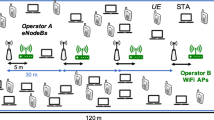Abstract
The increasing traffic demand will require additional spectrum to be used for mobile broadband. Licensed Shared Access (LSA) is one option for mobile network operators (MNO) to provide access to spectrum resources of other radio services, which are underutilized for specific time intervals and location areas, ensuring interference free coexistence between the sharing partners, i.e. this utilization of the spectrum requires decoupling of the resources in spatial or time domain. Indoor small cell deployments are particularly interesting for such a sharing scenario, due to the additional attenuation from the walls providing additional decoupling of the two systems. This article analyzes the network planning feasibility for LSA spectrum usage in indoor small cell scenarios. On basis of real indoor-to-outdoor propagation measurements and existing propagation models, a minimum decoupling range is determined where the LSA signal penetrating to the outdoor area falls below a certain threshold that guarantees interference free operation of the incumbent.
The original version of this chapter was revised.
An erratum to this chapter can be found at 10.1007/978-3-319-40352-6_63
An erratum to this chapter can be found at http://dx.doi.org/10.1007/978-3-319-40352-6_63
Access this chapter
Tax calculation will be finalised at checkout
Purchases are for personal use only
Similar content being viewed by others
Notes
- 1.
The Radio Spectrum Policy Group (RSPG) and the European Commission largely adopted and generalized the concept but renamed it to Licensed Shared Access where ASA is framed within LSA.
References
Optimising spectrum utilisation towards 2020. White Paper, Nokia, Espoo (2014). http://networks.nokia.com/file/30301/optimising-spectrum-utilisation-towards-2020
LTE for unlicensed spectrum. White Paper, Nokia, Espoo (2014). http://networks.nokia.com/file/34596/lte-for-unlicensed-spectrum
CEPT: ECC Report 205 - Licensed Shared Access (LSA). Technical report, February 2013
Khun-Jush, J., Bender, P., Deschamps, B., Gundlach, M.: Licensed shared access as complementary approach to meet spectrum demands: benefits for next generation cellular systems. In: ETSI Workshop on Reconfigurable Radiosystems, Cannes (2012)
Indoor deployment strategies. White Paper, Nokia (2014). http://networks.nokia.com/file/32531/indoor-deployment-strategies
Perez, E., Friederichs, K.-J., Viering, I., Diego Naranjo, J.: Optimization of authorised/licensed shared access resources. In: 2014 9th International Conference on Cognitive Radio Oriented Wireless Networks and Communications (CROWNCOM), pp. 241–246, June 2014
Universal Terrestrial Radio Access (UTRA) and Evolved Universal Terrestrial Radio Access (E-UTRA); Radio measurement collection for Minimaztion of Drive Test (MDT), 3GPP. Technical Specification, Technical report TS 37.320, September 2014
Evolved Universal Terrestrial Radio Access (E-UTRA); Further Advancements for E-UTRA physical layer aspect, 3GPP. Technical report, TR 36.814, March 2010
Universal Mobile Telecommunications System (UMTS): Radio Frequency (RF) system scenarios, 3GPP Technical report, TR 25.914, October 2012
Hata, M.: Empirical formula for propagation loss in land mobile radio services. IEEE Trans. Veh. Technol. 29(3), 317–325 (1980)
Hillery, W., Cudak, M., Ghosh, A., Vejlgaard, B.: Inside-out: can indoor femto cells satisfy outdoor coverage and capacity needs? In: IEEE Globecom Workshops (GC Wkshps), pp. 339–344, December 2013
Predicting coverage and interference involving the indoor-outdoor interface. White Paper, OFCOM (2007). http://stakeholders.ofcom.org.uk/binaries/research/technology-research/report1.pdf
Pekka, K., Juha, M., Lassi, H., et al.: WINNER II channel models part II radio channel measurement and analysis results. WINNER II, Munich, Germany, Technical report IST-4-027756 D, vol. 1 (2007)
CEPT: ECC Report 172 - Broadband Wireless Systems Usage in 2300–2400 MHz. Technical report, April 2012
CEPT: ECC Report 204 - Spectrum use and future requirements for PMSE. Technical report, February 2014
Author information
Authors and Affiliations
Corresponding author
Editor information
Editors and Affiliations
Rights and permissions
Copyright information
© 2016 ICST Institute for Computer Sciences, Social Informatics and Telecommunications Engineering
About this paper
Cite this paper
Perez, E., Friederichs, KJ., Lobinger, A., Wegmann, B., Viering, I. (2016). Utilization of Licensed Shared Access Resources in Indoor Small Cells Scenarios. In: Noguet, D., Moessner, K., Palicot, J. (eds) Cognitive Radio Oriented Wireless Networks. CrownCom 2016. Lecture Notes of the Institute for Computer Sciences, Social Informatics and Telecommunications Engineering, vol 172. Springer, Cham. https://doi.org/10.1007/978-3-319-40352-6_38
Download citation
DOI: https://doi.org/10.1007/978-3-319-40352-6_38
Published:
Publisher Name: Springer, Cham
Print ISBN: 978-3-319-40351-9
Online ISBN: 978-3-319-40352-6
eBook Packages: Computer ScienceComputer Science (R0)




